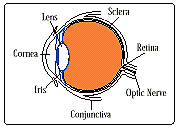 |
Vision, Aging and Age-Related Diseases
 By age 50, most of us experience some vision change. As your eyes
undergo normal aging changes, you can expect some or all of these changes in
vision: By age 50, most of us experience some vision change. As your eyes
undergo normal aging changes, you can expect some or all of these changes in
vision:
- Decrease in sharpness of vision
- Decrease in focusing power
As the lens of the eye becomes less flexible, it is
less able to focus. You'll notice it's harder for you to read fine print or see
close objects clearly. Called presbyopia, it occurs in the 40's and is
correctable with reading glasses or bifocals. For safety, identify medications
with large print labels; list emergency phone number in large print near the
telephone.
- Decrease in ability to see differences in colors
The lens of the eye yellows with age and filters out
colors at the blue end of the light spectrum, making it harder to see the
difference between shades of blue, green and violet.
- Decrease in ability to judge distances Increased need
for light
The eyes' pupils become less able to take in light and
less able to adapt to changes in light. You'll likely need more light to see
well. Use "warm" bulb lighting instead of "cold" fluorescent lighting; add
dimmer switches and three-way bulbs; add nightlights in bathrooms, hallways and
bedrooms;
use timers on lamps to avoid having to enter darkened areas.
- Increased sensitivity to glare
Sunlight, shiny floors, or reading a magazine with
shiny pages can cause blurred vision. Try sunglasses with yellow or amber
lenses; use mate finish polishes or waxes; order antiglare lenses for your
glasses; use an antiglare screen on your computer.
- Increased spots or specks
Called "floaters", they are most commonly seen against
white walls or in bright sunlight. They're annoying, but are normal and
harmless. However, if floaters appear with flashes of light or if they change
suddenly, see your eye doctor.
- Increased or decreased tearing
Dry, itching, burning eyes occur when the tear
glands don't produce enough tears. It may also be a sign of an infection or
blocked tear duct which needs to be treated. These eye diseases are more common
after 65:
- Cataracts – Normally, the lens of the eye is
clear. A cataract causes the lens to become cloudy. Vision becomes hazy and
blurred. The surgery is painless and has a high degree of success. The symptoms
are blurred or dimmed vision; a film-like fog over the eye; sensitivity to
light and glare; change in pupil color from black to milky grey, yellow or
white; faded colors; double vision or spots.
- Glaucoma – Your eye has an internal "plumbing"
system that constantly circu-lates and drains fluid from the eyes. A blockage
or too much fluid production can cause pressure build up and damage the optic
nerve. If detected early, it can be controlled with special eye drops. Yearly
eye exams are important because early stage glaucoma has no symptoms. Advancing
glaucoma symptoms include blurred vision; halos or colored rings around lights,
eye pain or redness, and loss of side vision.
- Macular Degeneration – Wear and tear of the
macula, a small area of the retina responsible for fine acute vision, causes
loss of central or straight ahead vision. It is the most common cause of new
cases of legal blindness for people over 55. The symptoms include dark, empty
or blurred space in center of vision; words on a page blur or disappear;
straight lines appear bent or wavy.
It isn't clear what causes macular degeneration and
most eyecare professionals will tell you there is no way to prevent it, but a
few studies suggest that antioxidant vitamins and some minerals could greatly
reduce the risk.
- The Beaver Dam Eye Study showed an increased risk for
macular degeneration in patients with the lowest levels of the antioxidant,
lycopene – found in fruits, veg-etables and…Pure Red Power.
- The Baltimore Longitudinal Study for Aging found that
higher blood levels of vita-mins E and C seem to protect people from macular
degeneration.
- The Eye Disease Case Control Study has found that
higher serum carotenoid (beta carotene) levels seem to protect people from
macular degeneration.
- The Macular Degeneration Risk Factor Study has found
less of the most serious type of macular degeneration in patients with high
antioxidant blood levels.
- A study published in the Archives of Ophthalmology
(February 1988) showed vision was less likely to deteriorate in macular
degeneration patients who were treated with zinc supplementation. Zinc was
studied because retinal zinc concentrations are usu-ally high, and zinc is an
important cofactor in retinal enzymes.
- A study published in JAMA (November 9, 1994) reported
that consumption of foods rich in the specific carotenoids, lutein and
zeaxan-thin resulted in the most reduced risk for macular degeneration. Dark
green, leafy vegetables, such as collard greens and spinach, are especially
rich in these carotenoids and were specifically linked to substantially reduced
risk.
|


|
 |



